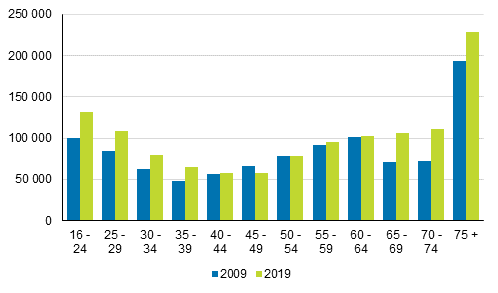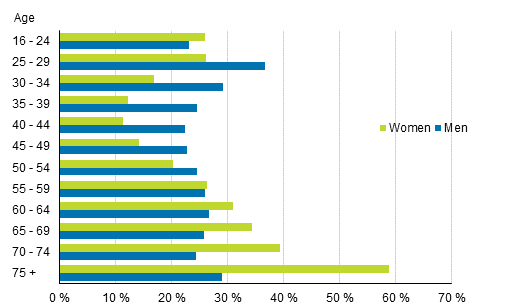Published: 20 May 2020
Living alone has become more common especially in the age groups of young and elderly people 2019
According to Statistics Finland, the number of persons living alone continued to grow in 2019. In comparison with the previous year, the number of persons living alone grew by around 30,000. In ten years, the number of persons living alone has grown most in the age groups of persons aged under 30 and persons aged over 65. In young age groups, living alone is more common for men, the majority of elderly people living alone are women. Living alone is most common in the age group of persons aged over 75, in which nearly every second person lives alone.
Household-dwelling units by number of persons in 1990 to 2019

There were altogether 2.73 million household-dwelling units at the end of 2019. The number of household-dwelling units grew by 28,720 from the previous year. The growth in the number of household-dwelling units is caused by the growing number of one-person and two-person households, because the number of larger household-dwelling units went down.
Number of one-person and two-person household-dwelling units continues growing
The number of small household-dwelling units continued to increase in 2019. In comparison with the previous year, the number of persons living alone grew by 2.5 percentage points. There were altogether over 1.2 million persons living alone, or nearly 45 per cent of all household-dwelling units. The number of two-person household-dwelling units increased slightly from the previous year, but the number of household-dwelling units with more members fell. Only 22,7 percent of household-dwelling units has more than two persons. The average household-dwelling unit size in 2019 was 1.97 persons.
Number of young and elderly people living alone has grown
In ten years, the number of one-person households has decreased only among those aged 45 to 54. By contrast, living alone has increased in all other age groups. The number of persons aged over 65 and persons aged under 30 living alone has grown in particular. Living alone has grown most among persons aged 70 to 74. In 2019, there were 55 per cent more persons belonging to this age group living alone than in 2009. The growth in the number of persons living alone in the age group is partly explained by the fact that persons belonging to the large age groups born between 1945 and 1949 were aged between 70 and 74 in 2019. In 2009, those belonging to the large age groups were aged 60 to 64 and were the largest age group of the working-age household-dwelling population living alone. In 2019, the number of persons aged over 70 living alone was altogether around 74,000 higher than ten years earlier.
Number of person living alone by the age group in 2009 and 2019

In relative terms, living alone has increased most among persons aged under 30. In 2009, altogether 20 per cent of those aged under 30 lived alone, while in 2019, the share of those living alone in the age group was 27 per cent. The change in housing allowance in 2017 seems to be connected to the growing number of young people living alone, living alone among persons aged under 30 grew especially after the change.
Living alone is still most common among persons aged over 75, of whom nearly every second lives alone. In relative terms there is no great change in elderly persons living alone. In 2009, the share of elderly persons living alone was 49 per cent, while in 2019, altogether 47 per cent of the age group lived alone. As a result of the longer life expectancy especially of men, people are widowed ever later, and this also has an effect on the relative decrease in living alone in the age group.
A young person living alone is more commonly a man, an elderly person living alone is a woman
There are more men than women living alone both in absolute numbers and in relative terms in the 25 to 54 age group. In turn, more women than men living alone are aged 55 or over and 24 or under.
The share of men living alone is highest among those aged 25 to 29. In the age group, 37 per cent of men live alone, while around one in four women of the same age live alone. The number of women living alone is highest both in absolute numbers and in relative terms among persons aged over 75. Fifty-nine per cent of women aged over 75 live alone, while only 29 per cent of men in the age group live alone.
Proportion of single men and women in the age group 2019, %

Source: Dwellings and Housing Conditions, Statistics Finland
Inquiries: Anu Rämö 029 551 3450, Arja Tiihonen 029 551 3272, info@stat.fi
Director in charge: Jari Tarkoma
Publication in pdf-format (246.4 kB)
- Tables
-
Tables in databases
Pick the data you need into tables, view the data as graphs, or download the data for your use.
Appendix tables
Updated 20.5.2020
Official Statistics of Finland (OSF):
Dwellings and housing conditions [e-publication].
ISSN=1798-6761. 2019. Helsinki: Statistics Finland [referred: 3.1.2026].
Access method: http://stat.fi/til/asas/2019/asas_2019_2020-05-20_tie_001_en.html

